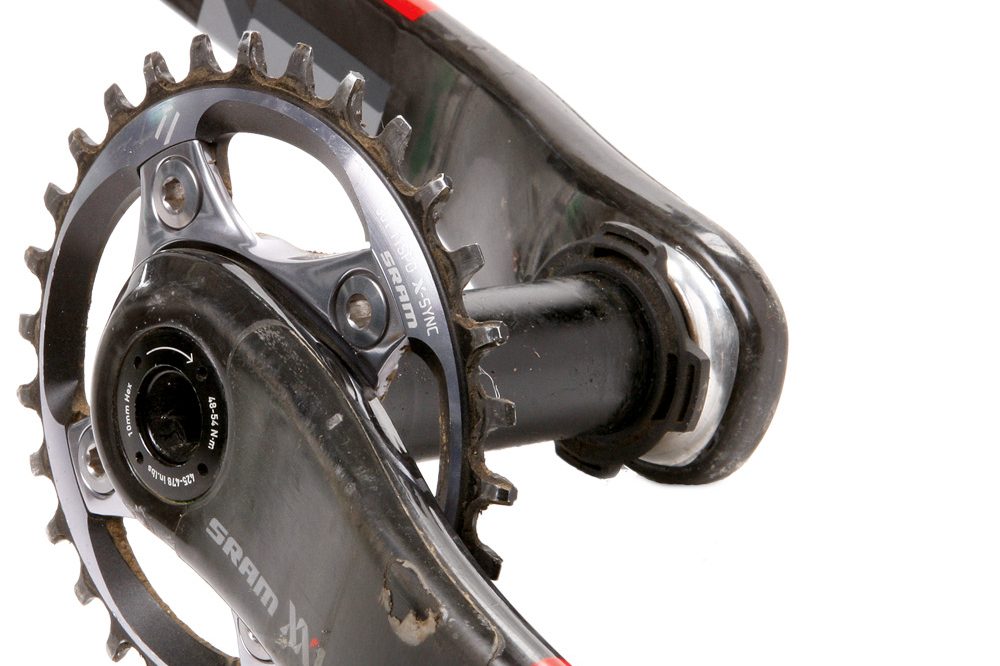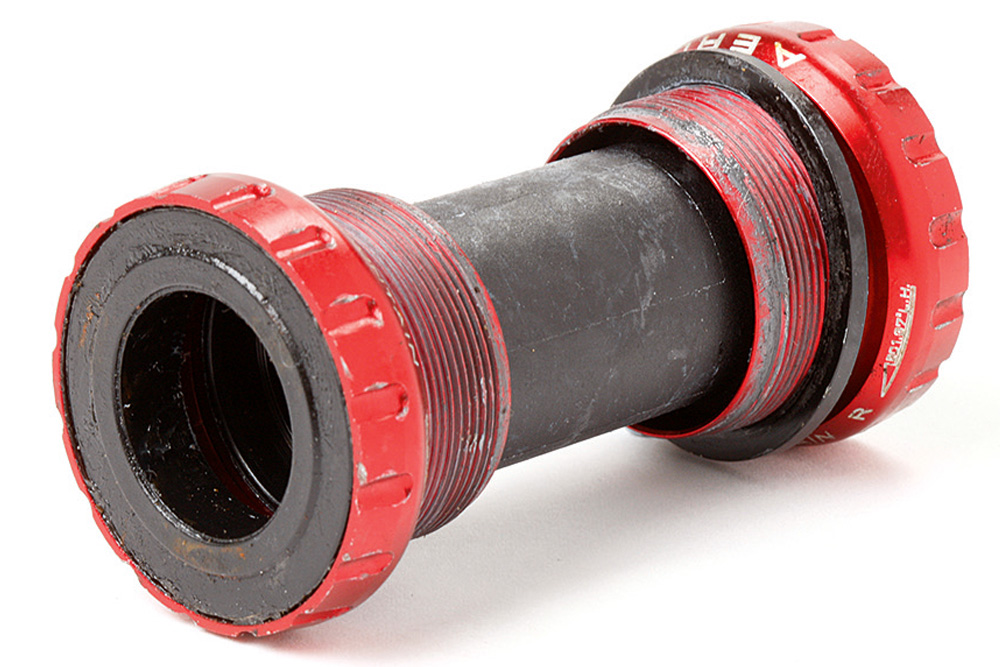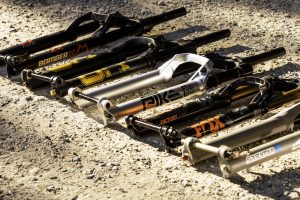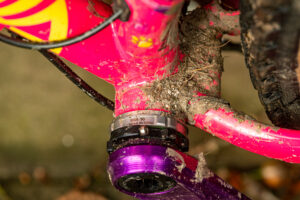Stoking the engine room, it’s easy to underestimate the importance of the best mountain bike cranks – and the better they are, the easier they are to forget
Looking for some new cranks to shave weight, increase efficiency, or just because you fancy it? We’ve tried and tested most cranksets available on the market, so if it’s on this list, you know they’re the best mountain bike cranks you can find.
They’ll almost certainly us a single front chainring, directly mounted to the drive-side arm. This negates the need for a clumsy and heavier front derailleur, cable and shifter, and with drivetrain advances stabilising the chain and increasing gearing range at the cassette, the benefits of this development are extensive.
If the price of cranks is making you think about replacing your whole drivetrain (we feel your pain), then check out our guide to the best mountain bike groupsets.

Shimano SLX M7100
Shimano SLX M7100
Best axle/crank interface
Weight: 520g | Lengths: 165, 170, 175mm | Rating: 10/10
Pros: Excellent hollow-forged crank arms and the most user-friendly axle/crank interface on the market. Easy to tension bearings
Cons: Steel axle and the chainring is not as smooth and hard-wearing as SRAM
The SLX cranks feel rock-solid, are proven bombproof and simply work. There’s no noticeable flex or loss of power, and the whole system plugs on without drama, to the point you simply don’t have to think about it. Shimano BBs are at least as durable as any others and come without a heavy price tag.
Read our full test review of the Shimano SLX M7100 crank

SRAM GX Eagle DUB Alloy
SRAM GX Eagle DUB Alloy
Best chainring design
Weight: 558g (no ring) | Lengths: 165, 170, 175mm | Rating: 10/10
Pros: Attractive design with broad crankarms. Sophisticated chainring design runs smoothly in the mud and lasts well
Cons: Forged and machined design is not as sophisticated as the Shimano hollow forged tech
SRAM’s cranks have become noticeably stiffer since the jump in axle size from 24mm to thicker alloy DUB spindles, and this extra solidity is presumably one of the reasons it no longer offers a pricier hollow-forged top-tier alloy crank option. So, instead of a tubular design, GX Eagle uses a forged alloy shaping that’s wider and flatter than most rivals, with reinforced webbing on the backside of the crank.
Read our full test review of the SRAM GX Eagle DUB Alloy crank

Shimano XT M8100
Shimano XT M8100
Not meaningfully superior to SLX but it’s nice to have the badge
Weight: 525g | Lengths: 165, 170, 175, 180mm | Rating: 9/10
Pros: Built tough. Easy to install/remove.
Cons: Performance not vastly superior to SLX
What can you say about the Shimano XT M8100 crank? They are a super-tough, proven product that’s been improved over generations, and have now caught up to the fact that nearly all modern bikes and riders prefer 1x drivetrains. Shimano’s latest chainrings are up to the job too, although still not as smooth as SRAM’s and also require a special tool (TL-FC41) for swapping chainrings, which is an extra potential headache.
Value is good here, but with SLX costing even less with no difference in performance that we can detect, we’d choose Shimano’s cheaper product here and save our pennies.
Read our full test review of the Shimano XT M8100 crank

SRAM X01 Eagle DUB Carbon
SRAM X01 Eagle DUB Carbon
Lighter and stiffer and totally bombproof
Weight: 481g (inc. ring) | Lengths: 165, 170, 175mm | Rating: 9/10
Pros: Carbon construction brings a weight saving. Crank boots protect from rock strikes.
Cons: It’s not a huge weight saving for the extra investment.
For more stiffness and weight saving, SRAM’s new aluminium axle is a hair under 29mm, a big leap up from the older (steel) 24mm one and closer to an oversized 30mm spindle. The new axle’s extra mm of space (over 30mm designs) sounds minimal, but it allowed engineers to better seal the BB against contamination and ensure lifespan is at least as good as the older GXP with its bigger balls. The latest chainsets are compatible with all current frame sizes with the correct BB too.
Read our full test review of the SRAM X01 Eagle DUB Carbon

Cane Creek eeWings
Cane Creek eeWings
Superior impact resistance, stiffness, durability and… just look at them
Weight: 404g | Lengths: 170, 175mm | Rating: 8/10
Pros: Worthy of any dream build. Very light. Solid under foot.
Cons: Need we say price?
Cane Creek eeWings not only look beautiful, they feel ultra-firm and efficient under power, plus the manufacturing quality and finish is first class. Add to that the super-durable and ding-resistant titanium construction and it makes for a great product. Even so, loads of riders likely wouldn’t tell much difference from a top alloy crank so the runner-up rating here is a reflection of the sky-high price tag.
Read our full test review of the Cane Creek eeWings

E*Thirteen XCX Race
E*Thirteen XCX Race
The lightest carbon crank on the market?
Weight: 346g | Lengths: 170, 172.5, 175mm | Rating: 8/10
Pros: Super light. Relatively good value.
Cons: Restrict them to XC/down-country use.
The E*Thirteen XCX Race crank is a niche product that delivers on its key objective. We wouldn’t recommend it for bikes with much more than 120/130mm travel, and heavier riders will notice some softness.
The weight saving-to-stiffness ratio is reminiscent of carbon cranks from 10 years ago, but this might be just what some riders are looking for. While £365 isn’t cheap, for the lightest carbon crank on the market, it isn’t overly expensive either.
Read our full test review of the E*Thirteen XCX Race crank

Hope Evo
Hope Evo
Hope’s second-generation mountain bike crank
Weight: 562g | Lengths: 165, 170, 175mm | Rating: 8/10
Pros: Beautiful machining. Vast array of colour options.
Cons: Expensive.
Hope’s latest cranks are around 40g lighter than before, plenty stiff enough and the fitment is now a doddle. Being British-made makes the price more than double that of quality alloy rivals from big OE rivals, but finish and function is excellent, and you can’t get this rainbow of bling colours anywhere else in the industry – if that’s what you’re after.
Read our full test review of the Hope Evo crank

Race Face Next R
Race Face Next R
Plenty stiff enough, impressively low weight, not overly expensive
Weight: 409g | Lengths: 170, 175mm | Rating: 9/10
Pros: Stiff and direct. Good price and weight.
Cons: No 165mm length.
Race Face Next R crank is arguably the stiffest carbon crank tested. There’s a marginally more positive and direct surge to power delivery than X01, although SRAM’s chainring is smoother to pedal. The Next Rs also come over a touch snappier when you’re really stomping down sprinting or leaning the bike hard through deep berms and trail kinks. It’s a sense of solidity that translates to a more responsive and tighter feel when riding.
Read our full test review of Race Face Next R crank
How we tested these cranks
Installing test cranks on the same bike allowed a direct comparison between each model regarding ease of installation, as well as stiffness and drivetrain smoothness. Cranks were then removed and handed out to various hard-riding friends to clock up winter miles in grit and grime. And, between us, we hit up a broad range of terrain including some serious jumps and long descents.
Final comparison was backed up by continual use and wider experience of many of the cranks here from test bikes evaluated through the year.

What to look for in the best mountain bike cranks
Crank materials range from traditional aluminium to lighter weight and more expensive carbon fibre and, in the case of one product here (with an eye-watering £1,000 price tag), also welded titanium.
It’s possible to spend well under a 100 quid on a decent set of cranks, right up to the aforementioned grand for Cane Creek’s, blinging eeWing numbers. In crude terms, the more you spend, the more weight you save, but beyond this there should be more sophisticated benefits such as extra durability and stiffness with pricier products.
The two main crank players are Shimano and SRAM; bolstered by the fact these brands offer complete drivetrain packages that put their products on many bikes as original equipment. Race Face cranks also get plenty of OEM action, and E*Thirteen, Hope and Cane Creek feature on some complete builds too, but these brands really concentrate on aftermarket upgrades, where their shiny products add extra bling factor.
Cranks should be a fit and forget product, so any issues with loosening, creaking or material failures are unacceptable in a market this mature. So, let’s dig in to what options are out there for your cash, and what are the pros and cons of the various systems and materials.
Leverage and crank length
Crank length refers to the length of the crank arms. In action, shorter arms spin in tighter circles and longer ones increase leverage for a more up/down energy transfer.
Multiple studies argue shorter arms and a smoother cadence can actually increase ultimate power, and it’s telling BMX racers and track cyclists – who sprint hardest – now commonly use 165mm for maximum speed.
We’re sold on the smoother power transfer of shorter cranks for increased climbing traction too.
There’s also an element of bike size, rider height and terrain to consider. Smaller frames and shorter riders typically use shorter cranks, the idea being that they are to scale with the bike, and vice versa. As mentioned above though, riders can change crank length depending on preference.
Another factor that can affect crank length choice is clearance from the ground, more on which further down this page.
Chainrings
All cranks here use single chainrings, which is our go-to set up here at MBR, and the industry default for most current and new cranks and groupsets.
The lone chainring allows ditching the front mech and associated weight, expense and faff.
Modern chainrings use an alternating thick/thin tooth profile to improve chain retention by meshing with chain links. SRAM arguably has the most sophisticated and effective tooth profiles on its X-Sync II rings.

Bottom bracket
Most cranks use either a 24mm or 30mm diameter axle. They don’t usually come with a bottom bracket, so you can mix and match brands.
SRAM’s latest DUB BB uses a unique axle diameter just under 29mm and requires an own brand unit or an adaptor to use with third parties. A larger axle is generally stiffer, but leaves less room for bigger bearings and seals.

Backside of a crank arm
Material
Cranks are usually made from one of three materials; aluminium, carbon or titanium, with ascending price in order listed.
The best alloy cranks are forged to align the grain structure of the aluminium, rather than machined, with some brands also using sophisticated forged hollow arms to save weight. Axle diameters vary from 24mm to 30mm, with various pros and cons to each.

Green crank boots on a crank arm
Crank boots
Carbon is more brittle and easier to damage or crack than aluminium, so plastic protective boots to shield crank tips against strikes are a wise investment. They do, however, add extra grams back in, which reduces any potential weight savings.
Also, crank boots can make it difficult to fit pedals with a stubby axle, as some won’t tighten fully without extra spacers.
Ground clearance
The three main crank lengths are 165, 170 and 175mm. Traditional logic dictated longer cranks mated better with longer legs, so larger bike sizes often used 175mm.
These days, clearance is king, and 170mm is popular to increase the gap between the ground and crank tips at the bottom of the pedal revolution to reduce strikes on rough trails.

Bolts can creak if not maintained
Stiffness
Ultimate stiffness should improve power delivery and reduce flex to increase responsiveness driving the bike with feet through turns ands features. Too much stiffness isn’t really an issue on full-suspension bikes, but a rock-solid crank on a hardtail might noticeably increase feedback ands abuse on feet on rough terrain.
















